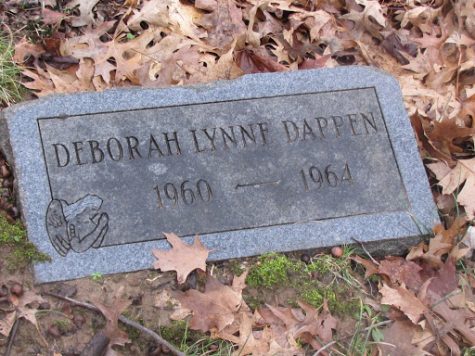Fairfax: The Summer of ’64
April 23, 2020
BY JOHNNY CARROLL
“It wasn’t pleasant, murder never is. I picked up two pieces of wallboard and pushed them aside. In the beam of Fairfax police Chief James Finan’s flashlight I saw a child’s arm and the bare midsection of her torso.” so begins a 1964 Cincinnati Enquirer Article written by crime reporter, Frank Weikel.
In the year 2020, Fairfax is a quiet town. There isn’t much crime except for the occasional teenage mischief and shoplifting from the local Red Bank Walmart. In the summer of 1964, Fairfax was a different town, a community struck by violence and confusion.
Four year old Debbie Dappen disappeared on Wednesday, August 19, 1964 from her Fairfax home when she went out to play after lunch. Her mother, Rosemary Dappen, reported her missing to the Fairfax Police Department.
Over the next two days more than 500 volunteers joined police in searching the Fairfax community, and the neighboring community of Madisonville. On August 21, 13-year-old George Rickey found a shoe in a culvert near Little Duck Creek. Debbie’s father, Karl Dappen identified the shoe as belonging to his four year old daughter.

Rickey reported finding the shoe in an area that was thoroughly searched the day before. Police concluded that the shoe had to have been planted after the search.
A tip from one Fairfax community member reported that Rickey had been seen that Friday peering through the side of his front porch. This series of facts led police to the conclusion that the Rickey residence had to be searched.
At 11 o’clock on Aug. 21, Fairfax Police Chief James Finan alongside crime reporter Frank Weikel, went to the home of Rickey and asked permission to search the house.
Mrs. Alicia Rickey, the juvenile’s mother, granted permission to the police to search the property. Reporter Mr. Weikel climbed into the side opening underneath the front porch and discovered Dappen’s lifeless body underneath scattered debris.
According to a police tape, 13-year-old Rickey confessed in under an hour to luring Dappen into his home to play hide and seek. According to his confession, he made a sexual advance on the four year old in his upstairs bedroom and stabbed her with a 10-inch butcher knife, then strangled her to death on top of his bed when she screamed. Afterwards, Rickey dragged her to the bathroom, washed the blood off her body, and put a band-aid over her wound. He carried Dappen out his side door, and stuffed her body underneath his front porch.
Shortly after her death, the Deborah Dappen Fund was developed. The money accumulated went towards a room in Fairfax Presbyterian church (now the New Life Worship Center) designed for mothers who want to bring their children to church services. At one time a plaque on the wall once designated the room as the “Deborah Dappen Cry Room.”


Rickey was a troubled child. According to Harvard psychologist Robert T Muller, “Prepubescent children are not fully emotionally developed, and less able to use self-control and appreciate the consequences of their actions. This, in combination with the fact that many child murderers are impulsive, aggressive, and unable to deal with their emotions, which suggests that when children kill, they are treating their victim as a target, as an outlet for violence. Most victims are either much younger than or close to the same age as the perpetrators, which may suggest they were chosen because they could be overpowered easily.”
The most recent public records show that Rickey was released in 1970 from the Ohio Youth Commission. Soon after, he was charged with assault with intent to rob in Columbus Ohio, and sent to Lima State Hospital but then was shortly released and placed on probation until 1972.
In 1973 he assaulted a 42-year-old woman and was sentenced to one to twenty years in the Mansfield Reformatory with charges of sodomy, malicous entry and torture. Rickey is now married and lives in Iowa less than a block away from an elementary school.
Recently I was visiting my close friend who now lives at the Dappen residence. I had taken very few visits inside the home, and this time it felt different. The white walls of the house seemed sad. Dinner was cooking in the kitchen while we watched TV in the living room where Dappen once played. The family’s cat was sitting on the cement ledge on the outside porch overlooking the sewer drain where Dappen once sat. The memories of the past seemed ingrained into the beige carpeted floors, and the quaintly designed windows.
As I was walking out the front door, I felt a sharp pull. I looked behind the door. Nothing. It felt like something didn’t want me to leave. A memory that was fighting to be remembered again. “Don’t leave, stay a little longer.” I imagined. I felt a frog in my throat. I didn’t feel scared, I felt helpless. I wanted to cry. I took one last long stare inside the family room, and shut the door.
This story has no theme, no underlying messages. It’s a sad story about a four year-old girl who could have been any one of our sisters, neighbors, or friends. If Dappen was alive today she would be sixty years-old.


Missy Miller • Apr 27, 2022 at 5:45 am
My family and I had just moved from Fairfax to Milford. I remember this very well, because it hit home ,,way too close. Plus I went to school with his brother, what a tragic story, especially for Debbie Dappen, and her family. Imagine, a 4 year old, little girl???? He deserves death penalty!!!!
VLW • Feb 19, 2022 at 7:42 pm
I’ve never forgotten this murder. I would have been 7 years old, and I remember following it as best I was able from the Cincinnati Enquirer. I was especially struck by the shoe being “found” by the boy who later turned out to have been the murderer, and the poor girl’s body being found under the porch. Very disturbing!
Sharon Gearheard • Jan 20, 2022 at 1:15 pm
I am related to George Rickey. My mom told me of this story awhile ago. I have never met him or spoken to him.
Larry Roberts • Oct 8, 2020 at 12:48 pm
Well written. I was the reporter for WCKY who followed a George Rickey around the day he found Debbies shoe. I saw him open a door under his front porch, called him to my news car, it was raining. I asked him what’s under there. He says, oh, nothing, just some cardboard. I went straight to Chief Finan and urged him to search under the porch. Cops waited til dark that night. Big cop couldn’t fit through the hole, so they sent skinning Weikel under there, Enquirer headline. Enquirer Reporter Finds Debbies Body. I was a young 23 year old reporter who got scooped on my own story!
Missy Miller • Apr 27, 2022 at 5:50 am
You are very smart. That must have been a scary situation.
Missy Miller • Apr 27, 2022 at 5:51 am
You are very smart. That must have b a scary situation.
Andrew Carroll • Apr 30, 2020 at 8:33 am
great piece. Writer shows great potential. The next Stephen King.
Jim Christopher • Apr 30, 2020 at 6:52 am
Very interesting article and well written. The story is one we don’t normally hear about and it’s very nice that this young girl was remembered. Thanks for sharing.